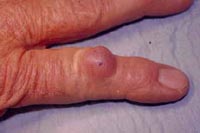| Lumps & Bumps
Lumps and Bumps of the Hand Growths or tumors of any kind are often and understandably
quite distressing. In particular, a lump or bump involving the hand or wrist
can be more noticeable and thus even more unnerving. Fortunately, the vast majority
of such lesions are benign, and can be safely and successfully treated with
both surgical and non-surgical means.
When one hears of a tumor, the immediate concern is that of cancer. Actually,
the word tumor derives from the Latin for swelling, and can comprise any number
of conditions, a few of which are neoplasms. A neoplasm (Greek for a new thing
formed) is what people actually mean when they use the more general term of
tumor. A neoplasm, then, can be benign ("kind") or malignant (related to "malicious").
It is the malignant type of neoplasm which is known as cancer.
The overwhelming majority of lumps or bumps of the hand are not cancerous.
This is not to say to ignore a growth on the hand, but to rest assured that
with proper diagnosis, the preponderance of such lesions can be addressed relatively
simply.
A complete list of all growths that may exist in the hand or wrist would be
very large. However, as this list contains a predominance of non-neoplastic
tumors, what follows is a brief description of some of these conditions.
Up to 90% of all tumors in the hand and wrist are ganglions, from the Greek
for swelling or knot. Ganglions are fluid-filled cysts which are sometimes associated
with pain and may be worsened by certain activities with the wrist or finger.
They are most commonly found on the back of the wrist, then in decreasing frequency
on the palm side of the wrist, palm side of the finger, and last joint in the
finger. In the younger population, these are seen more commonly at the wrist
or the base of the finger. In the older population, they are found more at the
last joint of the finger, and in this circumstance represent (very common) arthritic
changes at this joint. The cause remains unknown, although it is generally felt
that they are associated with the nearby joint. The treatment frequently involves
simply alleviating the fear that this does not represent a serious tumor. In
cases of sufficiently disturbing pain, removing the fluid with a needle will
temporarily remove the cyst, and occasionally is a permanent cure. The definitive
treatment is surgical excision, primarily performed because of the cosmetic
appearance or if there is enough pain.
Thickening at the middle or last joint of the finger is very common in the
older patient and represents bone spurs which form as part of the process of
degenerative arthritis (osteoarthritis) at those joints. There may be mild pain
and stiffness, but rarely the pain is so severe that surgery is required. The
treatment is symptomatic and usually comprises the use of anti-inflammatory
medications or TylenolR, and occasional splinting. If the pain is not adequately
treated by these means, surgical intervention usually provides complete relief.
Dupuytren's contracture or disease, named after a French surgeon, is thought
to be a genetic condition which originated in the Celtic races of northern Europe.
Due to wide dissemination of different peoples, it has been reported throughout
the world, although is more commonly seen in people (more commonly men) with
this ancestry. The disease involves abnormal thickening of the normal gristle-type
tissue just under the skin in the palm and in the fingers, usually more so on
the little finger side of the hand. Frequently, the only treatment necessary
is assurance of the proper diagnosis. On occasion, the contracture of this tissue
results in drawing up of the fingers. When this occurs, medical attention should
be sought so that this may be addressed. Unfortunately, the only certain treatment
is surgical removal of the diseased tissue. However, the results of surgery
are much better if it is caught before the fingers are drawn into the palm.
Any lesion of the skin on the hand or wrist needs to be evaluated. This is
particularly true if there is progressive enlargement, raised edges, or discoloration.
While the majority of such lesions are benign, on occasion such a lesion may
be malignant. It is because of this possibility of cancer that an early diagnosis
and appropriate treatment are essential. Often, removal of the abnormality,
if necessary, achieves two goals of eradication of the lesion and the ability
to provide an accurate diagnosis by the pathologist.
In summary, while it is important to be aware of any lumps or bumps on the
hand, it should be comforting to know that nearly all are not cancerous, and
essentially all can be successfully treated once a proper diagnosis is made.

|